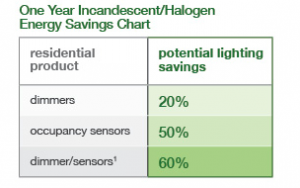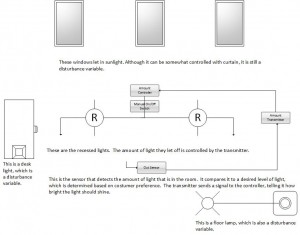Artificial light is an integral part of life. Without it, daily functions would be restricted to the hours of natural light provided by the sun. With 24-hour access to artificial light, the workday can turn into the “work night.” Although artificial light is extremely beneficial, it also has its downfalls. One main disadvantage is the vast amounts of energy consumption. Even though artificial light is needed, not every circumstance calls for blinding amounts of light when there is perfectly good natural light right outside the window. However, many artificial lights only have one setting which leads to two options: total darkness or full on blinding light. This can lead to a huge waste of energy. Flipping a light switch or walking down a well-lit hallway are both everyday luxuries that are often taken for granted. The easy access of artificial light has resulted in abuse of it as a resource. Figure 1 shows the potential savings by using dimmers.

This energy could be conserved if there was a system that measured the amount of light present and then only supplied enough artificial light that is needed. For example, imagine if during the peak hours of sunlight, artificial lights would dim automatically to adjust for an increase in sunlight. This would decrease the amount of energy use and, ultimately, save money. As the sun begins to set, the artificial lights in a room would compensate for the loss of natural light to keep a constant and desired amount of light in a room. The idea of auto dimming has many benefits other than saving energy and money, like extending the life of a light bulb, creating a more productive atmosphere, and a healthier life in general.
The reason why this product is so valuable is that it can reinvent the way people not only light their homes, but also office buildings, schools, and other public spaces. In public spaces, people don’t usually pay much attention to the status of the lights and often forget to turn them off when they leave a room. Along with over use of artificial light when people are in the room, there is even more wasted energy of when people leave lights on in an empty room. This product will not only have auto dimming but also a controller that can dictate when lights should turn off and on at the beginning and end of a work day.
This auto dimming lighting system uses a sensor that detects the brightness in a room, which then transmit a signal to the artificial light, which also has a sensor attached to it. The sensor will then tell the controller to dim or brighten the artificial light according to the amount of natural light already present in the room. For example, at night the amount of artificial light will be the highest level since there is no sunlight available. As the sun starts to rise, the amount of artificial light starts to decrease since the amount of light already present starts to increase due to the increase of sunlight. Unlike a timer system which would just have the amount of artificial light increasing and then decreasing with respect to time, a process controller would also allow for the total amount of light to stay constant even on cloudy days. A similar control process is used in devices such as IPhone and IPad in order to adjust the brightness of the screen in response to the lighting of the surrounding environment.
The controlled variable is the amount of light in the room. To determine the ranges of this variable, the consumer would do a calibration based on their preference of what the desired amount of light in the room should be. This would include light in the early morning, mid-morning, midday afternoon, evening and night. The control of this variable is crucial to the operation of this product because if the light is not controlled, the dimmer will not work properly and provide adequate amounts of light. However, since lights can be controlled manually by a person flipping a switch, controlling the amount of light is not crucial to the original function of the light.
The manipulated variable of this process is the amount of artificial light in the room. However, it would only be the overhead artificial light sources. Other sources of artificial light, like floor lamps, flashlights, and desk lamp would not be considered manipulated variables because they are used for additional light needed for specific locations. These would be considered disturbance variables since when a lamp is turned on, the ceiling lights or recessed lighting would adjust based on the amount of light in the room. Other disturbance variables are the amount of light coming into the room and where it shines. For example, if curtains are suddenly closed, the system needs to respond quickly so that the person in the room is not left in the dark. It is more practical for the artificial light to be the manipulated variable than the sunlight since it would be harder to control the amount of sunlight coming into the room with curtains or mirrors.
These disturbance variables would all be controlled by the same manipulated variable, the amount of artificial light, by way of a feedback loop. A feedback loop is when the output of the system is compared to a known or ideal value. The difference between the desired amount of light and the actual amount of light in the room is then turned into an error signal that is transmitted to a controller. The controller would then adjust the amount of artificial light supplied to the room based on this error. Figure 2 shows how all the variables interact.

Installing this controller is better for the environment and the user’s wallet because it ensures the minimum amount of electricity, and thus energy, is used throughout the day. The video below demonstrates how the auto dimming lights can be used in daily life. As the curtain rises, the artificial light in the room begins to dim. However, the total light in the room remains the same. Thousands of watts of energy are unnecessarily wasted because the availability of natural light that is neglected. And God said let there be light, NATURAL light. So use it, dang it!